Xian Shi
CosyVoice 3: Towards In-the-wild Speech Generation via Scaling-up and Post-training
May 23, 2025Abstract:In our prior works, we introduced a scalable streaming speech synthesis model, CosyVoice 2, which integrates a large language model (LLM) and a chunk-aware flow matching (FM) model, and achieves low-latency bi-streaming speech synthesis and human-parity quality. Despite these advancements, CosyVoice 2 exhibits limitations in language coverage, domain diversity, data volume, text formats, and post-training techniques. In this paper, we present CosyVoice 3, an improved model designed for zero-shot multilingual speech synthesis in the wild, surpassing its predecessor in content consistency, speaker similarity, and prosody naturalness. Key features of CosyVoice 3 include: 1) A novel speech tokenizer to improve prosody naturalness, developed via supervised multi-task training, including automatic speech recognition, speech emotion recognition, language identification, audio event detection, and speaker analysis. 2) A new differentiable reward model for post-training applicable not only to CosyVoice 3 but also to other LLM-based speech synthesis models. 3) Dataset Size Scaling: Training data is expanded from ten thousand hours to one million hours, encompassing 9 languages and 18 Chinese dialects across various domains and text formats. 4) Model Size Scaling: Model parameters are increased from 0.5 billion to 1.5 billion, resulting in enhanced performance on our multilingual benchmark due to the larger model capacity. These advancements contribute significantly to the progress of speech synthesis in the wild. We encourage readers to listen to the demo at https://funaudiollm.github.io/cosyvoice3.
ThermoONet -- a deep learning-based small body thermophysical network: applications to modelling water activity of comets
May 20, 2025Abstract:Cometary activity is a compelling subject of study, with thermophysical models playing a pivotal role in its understanding. However, traditional numerical solutions for small body thermophysical models are computationally intensive, posing challenges for investigations requiring high-resolution or repetitive modeling. To address this limitation, we employed a machine learning approach to develop ThermoONet - a neural network designed to predict the temperature and water ice sublimation flux of comets. Performance evaluations indicate that ThermoONet achieves a low average error in subsurface temperature of approximately 2% relative to the numerical simulation, while reducing computational time by nearly six orders of magnitude. We applied ThermoONet to model the water activity of comets 67P/Churyumov-Gerasimenko and 21P/Giacobini-Zinner. By successfully fitting the water production rate curves of these comets, as obtained by the Rosetta mission and the SOHO telescope, respectively, we demonstrate the network's effectiveness and efficiency. Furthermore, when combined with a global optimization algorithm, ThermoONet proves capable of retrieving the physical properties of target bodies.
MinMo: A Multimodal Large Language Model for Seamless Voice Interaction
Jan 10, 2025



Abstract:Recent advancements in large language models (LLMs) and multimodal speech-text models have laid the groundwork for seamless voice interactions, enabling real-time, natural, and human-like conversations. Previous models for voice interactions are categorized as native and aligned. Native models integrate speech and text processing in one framework but struggle with issues like differing sequence lengths and insufficient pre-training. Aligned models maintain text LLM capabilities but are often limited by small datasets and a narrow focus on speech tasks. In this work, we introduce MinMo, a Multimodal Large Language Model with approximately 8B parameters for seamless voice interaction. We address the main limitations of prior aligned multimodal models. We train MinMo through multiple stages of speech-to-text alignment, text-to-speech alignment, speech-to-speech alignment, and duplex interaction alignment, on 1.4 million hours of diverse speech data and a broad range of speech tasks. After the multi-stage training, MinMo achieves state-of-the-art performance across various benchmarks for voice comprehension and generation while maintaining the capabilities of text LLMs, and also facilitates full-duplex conversation, that is, simultaneous two-way communication between the user and the system. Moreover, we propose a novel and simple voice decoder that outperforms prior models in voice generation. The enhanced instruction-following capabilities of MinMo supports controlling speech generation based on user instructions, with various nuances including emotions, dialects, and speaking rates, and mimicking specific voices. For MinMo, the speech-to-text latency is approximately 100ms, full-duplex latency is approximately 600ms in theory and 800ms in practice. The MinMo project web page is https://funaudiollm.github.io/minmo, and the code and models will be released soon.
CosyVoice 2: Scalable Streaming Speech Synthesis with Large Language Models
Dec 13, 2024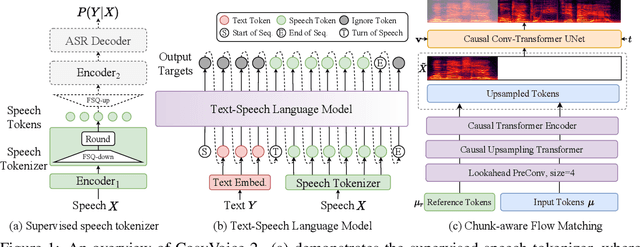

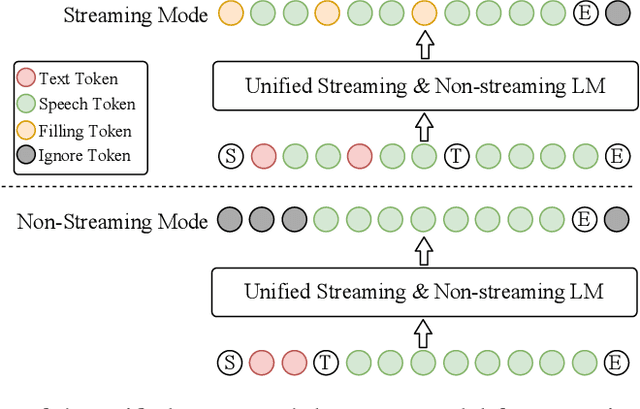

Abstract:In our previous work, we introduced CosyVoice, a multilingual speech synthesis model based on supervised discrete speech tokens. By employing progressive semantic decoding with two popular generative models, language models (LMs) and Flow Matching, CosyVoice demonstrated high prosody naturalness, content consistency, and speaker similarity in speech in-context learning. Recently, significant progress has been made in multi-modal large language models (LLMs), where the response latency and real-time factor of speech synthesis play a crucial role in the interactive experience. Therefore, in this report, we present an improved streaming speech synthesis model, CosyVoice 2, which incorporates comprehensive and systematic optimizations. Specifically, we introduce finite-scalar quantization to improve the codebook utilization of speech tokens. For the text-speech LM, we streamline the model architecture to allow direct use of a pre-trained LLM as the backbone. In addition, we develop a chunk-aware causal flow matching model to support various synthesis scenarios, enabling both streaming and non-streaming synthesis within a single model. By training on a large-scale multilingual dataset, CosyVoice 2 achieves human-parity naturalness, minimal response latency, and virtually lossless synthesis quality in the streaming mode. We invite readers to listen to the demos at https://funaudiollm.github.io/cosyvoice2.
Deep operator neural network applied to efficient computation of asteroid surface temperature and the Yarkovsky effect
Nov 04, 2024



Abstract:Surface temperature distribution is crucial for thermal property-based studies about irregular asteroids in our Solar System. While direct numerical simulations could model surface temperatures with high fidelity, they often take a significant amount of computational time, especially for problems where temperature distributions are required to be repeatedly calculated. To this end, deep operator neural network (DeepONet) provides a powerful tool due to its high computational efficiency and generalization ability. In this work, we applied DeepONet to the modelling of asteroid surface temperatures. Results show that the trained network is able to predict temperature with an accuracy of ~1% on average, while the computational cost is five orders of magnitude lower, hence enabling thermal property analysis in a multidimensional parameter space. As a preliminary application, we analyzed the orbital evolution of asteroids through direct N-body simulations embedded with instantaneous Yarkovsky effect inferred by DeepONet-based thermophysical modelling.Taking asteroids (3200) Phaethon and (89433) 2001 WM41 as examples, we show the efficacy and efficiency of our AI-based approach.
LCB-net: Long-Context Biasing for Audio-Visual Speech Recognition
Jan 12, 2024Abstract:The growing prevalence of online conferences and courses presents a new challenge in improving automatic speech recognition (ASR) with enriched textual information from video slides. In contrast to rare phrase lists, the slides within videos are synchronized in real-time with the speech, enabling the extraction of long contextual bias. Therefore, we propose a novel long-context biasing network (LCB-net) for audio-visual speech recognition (AVSR) to leverage the long-context information available in videos effectively. Specifically, we adopt a bi-encoder architecture to simultaneously model audio and long-context biasing. Besides, we also propose a biasing prediction module that utilizes binary cross entropy (BCE) loss to explicitly determine biased phrases in the long-context biasing. Furthermore, we introduce a dynamic contextual phrases simulation to enhance the generalization and robustness of our LCB-net. Experiments on the SlideSpeech, a large-scale audio-visual corpus enriched with slides, reveal that our proposed LCB-net outperforms general ASR model by 9.4%/9.1%/10.9% relative WER/U-WER/B-WER reduction on test set, which enjoys high unbiased and biased performance. Moreover, we also evaluate our model on LibriSpeech corpus, leading to 23.8%/19.2%/35.4% relative WER/U-WER/B-WER reduction over the ASR model.
SlideSpeech: A Large-Scale Slide-Enriched Audio-Visual Corpus
Sep 12, 2023Abstract:Multi-Modal automatic speech recognition (ASR) techniques aim to leverage additional modalities to improve the performance of speech recognition systems. While existing approaches primarily focus on video or contextual information, the utilization of extra supplementary textual information has been overlooked. Recognizing the abundance of online conference videos with slides, which provide rich domain-specific information in the form of text and images, we release SlideSpeech, a large-scale audio-visual corpus enriched with slides. The corpus contains 1,705 videos, 1,000+ hours, with 473 hours of high-quality transcribed speech. Moreover, the corpus contains a significant amount of real-time synchronized slides. In this work, we present the pipeline for constructing the corpus and propose baseline methods for utilizing text information in the visual slide context. Through the application of keyword extraction and contextual ASR methods in the benchmark system, we demonstrate the potential of improving speech recognition performance by incorporating textual information from supplementary video slides.
SeACo-Paraformer: A Non-Autoregressive ASR System with Flexible and Effective Hotword Customization Ability
Aug 16, 2023



Abstract:Hotword customization is one of the important issues remained in ASR field - it is of value to enable users of ASR systems to customize names of entities, persons and other phrases. The past few years have seen both implicit and explicit modeling strategies for ASR contextualization developed. While these approaches have performed adequately, they still exhibit certain shortcomings such as instability in effectiveness. In this paper we propose Semantic-augmented Contextual-Paraformer (SeACo-Paraformer) a novel NAR based ASR system with flexible and effective hotword customization ability. It combines the accuracy of the AED-based model, the efficiency of the NAR model, and the excellent performance in contextualization. In 50,000 hours industrial big data experiments, our proposed model outperforms strong baselines in customization and general ASR tasks. Besides, we explore an efficient way to filter large scale incoming hotwords for further improvement. The source codes and industrial models proposed and compared are all opened as well as two hotword test sets.
Accurate and Reliable Confidence Estimation Based on Non-Autoregressive End-to-End Speech Recognition System
May 25, 2023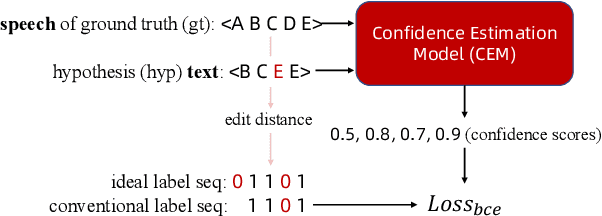

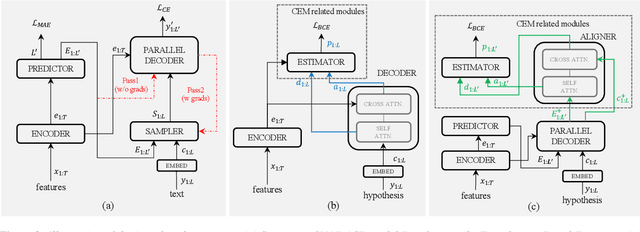
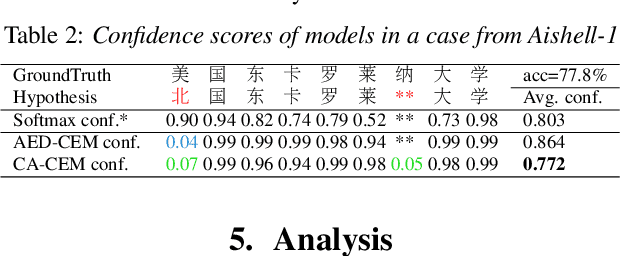
Abstract:Estimating confidence scores for recognition results is a classic task in ASR field and of vital importance for kinds of downstream tasks and training strategies. Previous end-to-end~(E2E) based confidence estimation models (CEM) predict score sequences of equal length with input transcriptions, leading to unreliable estimation when deletion and insertion errors occur. In this paper we proposed CIF-Aligned confidence estimation model (CA-CEM) to achieve accurate and reliable confidence estimation based on novel non-autoregressive E2E ASR model - Paraformer. CA-CEM utilizes the modeling character of continuous integrate-and-fire (CIF) mechanism to generate token-synchronous acoustic embedding, which solves the estimation failure issue above. We measure the quality of estimation with AUC and RMSE in token level and ECE-U - a proposed metrics in utterance level. CA-CEM gains 24% and 19% relative reduction on ECE-U and also better AUC and RMSE on two test sets. Furthermore, we conduct analysis to explore the potential of CEM for different ASR related usage.
BAT: Boundary aware transducer for memory-efficient and low-latency ASR
May 19, 2023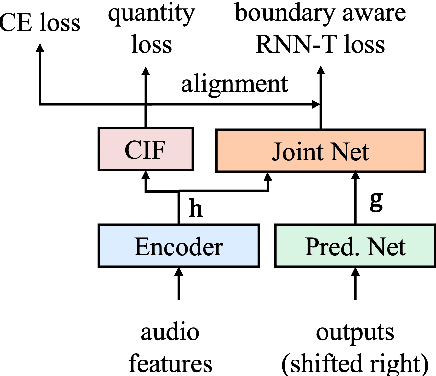
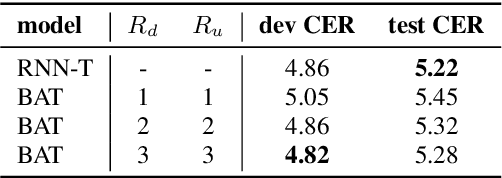
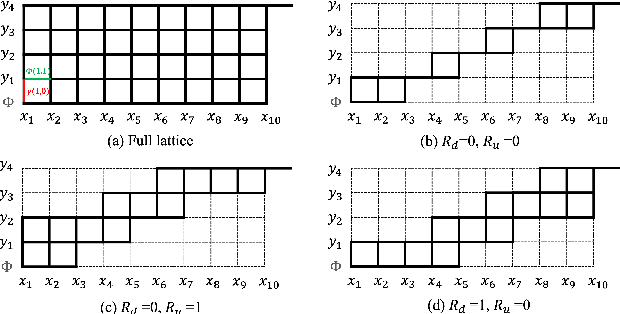

Abstract:Recently, recurrent neural network transducer (RNN-T) gains increasing popularity due to its natural streaming capability as well as superior performance. Nevertheless, RNN-T training requires large time and computation resources as RNN-T loss calculation is slow and consumes a lot of memory. Another limitation of RNN-T is that it tends to access more contexts for better performance, thus leading to higher emission latency in streaming ASR. In this paper we propose boundary-aware transducer (BAT) for memory-efficient and low-latency ASR. In BAT, the lattice for RNN-T loss computation is reduced to a restricted region selected by the alignment from continuous integrate-and-fire (CIF), which is jointly optimized with the RNN-T model. Extensive experiments demonstrate that compared to RNN-T, BAT reduces time and memory consumption significantly in training, and achieves good CER-latency trade-offs in inference for streaming ASR.
 Add to Chrome
Add to Chrome Add to Firefox
Add to Firefox Add to Edge
Add to Edge